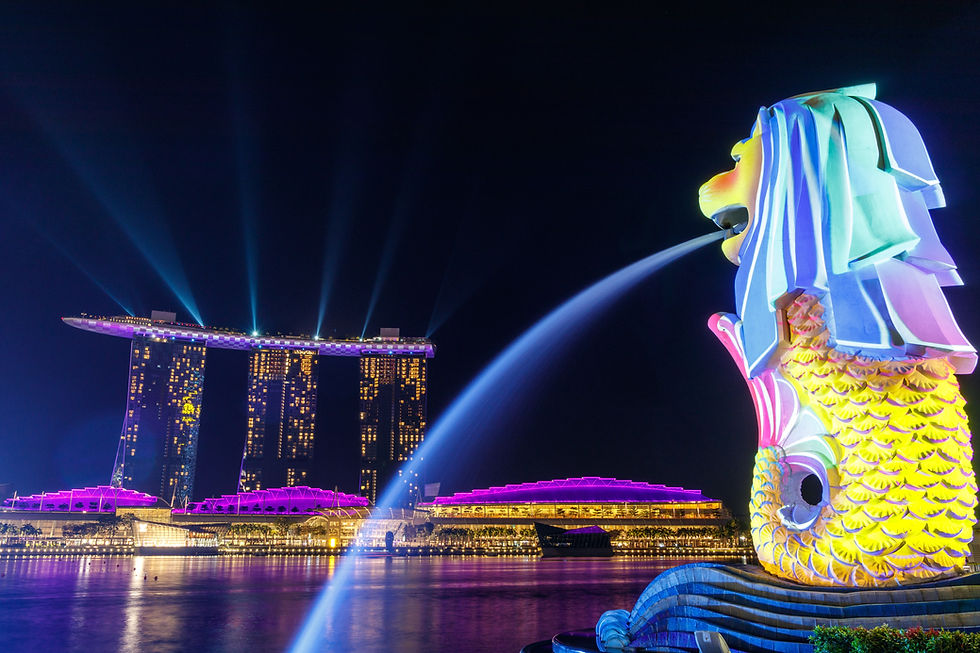
Dive into our blog post if you wanna gain knowledge about the historical landmarks and heritage of Singapore. In this blog post, we will take you through the history and transformation of Merlion Singapore.
Merlion Park stands as a quintessential landmark in Singapore, drawing in tourists and locals alike with its iconic statues of the mythical creature. With its rich history and symbolic significance, the park has undergone a notable evolution over the years, reflecting both changes in the city's landscape and shifts in tourism focus.
History
Birth of the Merlion (1972)
Designed by Fraser Brunner and sculpted by Lim Nang Seng, the original Merlion statue was unveiled at the mouth of the Singapore River, instantly becoming a beloved symbol of the city.
Symbolism and Popularity
Representing Singapore's fishing village origins (fish body) and its name's meaning ("lion city"), the statue quickly gained popularity among tourists, embodying the spirit of the nation.
Change of Scenery (1997)
The completion of the Esplanade Bridge altered the park's landscape, prompting the relocation of the Merlion to its current home near The Fullerton Hotel in 2002.
Relocation & Expansion (2002)
Recognizing the significance of the Merlion as a cultural icon, Singapore authorities decided to relocate the statue to a more prominent location near The Fullerton Hotel. This move aimed to ensure better visibility and accessibility for tourists while preserving the statue's historical and symbolic value.
The new pier, specially constructed to accommodate the Merlion, offered enhanced viewing platforms and a more spacious environment for visitors. Additionally, the relocation facilitated the addition of a smaller statue, known as the "Merlion cub," which provided a delightful and interactive experience for tourists.
The relocation, along with the expansion of the Merlion Park to four times its original size, required an investment of S$7.5 million. The process began on April 23, 2002, and concluded on April 28, 2002. The unveiling ceremony at the new spot, held on September 15, 2002, also celebrated the Merlion's 30th birthday. The park's strategic positioning along the Marina Bay waterfront further solidified its status as a premier destination for visitors seeking to immerse themselves in Singapore's vibrant culture and history.
Maintenance and Incidents
Over the years, the Merlion statues have undergone periodic maintenance due to corrosion from exposure to seawater. On February 28, 2009, the larger statue was struck by lightning during a thunderstorm, resulting in damage to its mane and the base. However, it was repaired and reopened to the public on March 18, 2009.

Recent Renovation
In 2023, the Singapore Tourism Board informed the public that the main Merlion statue at Merlion Park underwent repair work from September 25 to December 13. During this period, the main Merlion statue was covered in scaffolding and was not available for photo-taking. However, the public was welcome to take photos of the nearby Merlion cub statue at Merlion Park.

Nowadays
Despite the evolving tourism landscape and the emergence of newer attractions, Merlion Park remains a cherished symbol of Singapore. The statues continue to attract tourists from around the world, serving as iconic landmarks that symbolize the city-state's rich heritage and identity.
While newer attractions like Marina Bay Sands, Gardens by the Bay, and the Singapore Flyer have garnered attention in recent years, Merlion Park remains a must-visit destination for tourists seeking an authentic Singaporean experience. Its enduring popularity underscores the timeless appeal of the Merlion statues, which stand as enduring symbols of Singapore's past, present, and future.
The Merlion Statues in Singapore
In Singapore, there are seven Merlion statues approved by the STB (Singapore Tourism Board). Among these, the two most famous ones stand at the new Merlion Park near One Fullerton. These statues, designed to spout seawater from their mouths, hold significant cultural and touristic value for Singapore.
In addition to the main Merlion statues, Singapore boasts other notable Merlion installations. The Merlion tower on Sentosa, completed in 1996, stands at 37 meters and was designed by Australian sculptor James Martin. Another Merlion statue, standing at 3 meters tall, is located outside the STB's office at Tourism Court. Similarly, a Merlion statue can be found at Faber Point on Mount Faber, owned by the National Parks Board, and installed in 1998 after the park's redevelopment.

Conclusion
Merlion Park's evolution reflects the dynamic nature of Singapore's tourism industry, from its humble beginnings at the mouth of the Singapore River to its current status as a must-visit destination. While newer attractions may share the spotlight, the Merlion statues continue to stand tall, reminding visitors of the city-state's rich history and cultural legacy. As Singapore continues to evolve, Merlion Park remains an enduring symbol of the nation's spirit and identity, welcoming visitors to experience the magic of this vibrant city.
Curious to learn more?
Immerse yourself in our blog posts to unravel the rich tapestry of Singapore's history, culture, heritage, and community spanning from the past to the present. Let our blog be your gateway to a deeper understanding of the vibrant and diverse facets that shape Singapore's cultural landscape. Ready to delve into the captivating world of heritage and history? Check out our blogs now!

Comments